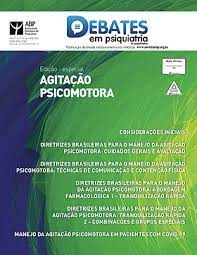Diretrizes brasileiras para o manejo da agitação psicomotora: cuidados gerais e avaliação
DOI:
https://doi.org/10.25118/2763-9037.2021.v11.12Palavras-chave:
Agitação psicomotora, agressividade, tranquilização farmacológica, emergência psiquiátricas, avaliação de risco, manejo não farmacológicoResumo
Neste primeiro artigo, apresentamos os aspectos gerais dessa diretriz. Na sequência, apresentamos os cuidados gerais do ambiente e equipe e, posteriormente, a avaliação de pacientes agitados, principalmente focada no diagnóstico diferencial. Número de registro da revisão sistemática: CRD42017054440.
Downloads
Métricas
Referências
Cordeiro DC, Baldacara L. Emergências psiquiátricas. São Paulo: Roca; 2007.
Barros RE, Marques JM, Carlotti IP, Zuardi AW, Del-Ben CM. Short admission in an emergency psychiatry unit can prevent prolonged lengths of stay in a psychiatric institution. Braz J Psychiatry. 2010;32:145-51.
Cruz CM, Leiva JL, Borgoño RV, Larach TK, Errázuriz LB, Chianale IC, et al. Epidemiología de la Urgencia Psiquiátrica en el Instituto Psiquiátrico“Dr. José Horwitz”: Un nuevo estudio comparativo. Rev Chil Neuro-psiquiatr. 2010;48:175-83.
Quevedo J, Carvalho AF. Emergências psiquiátricas.2ª ed. Porto Alegre: Artmed; 2014.
Garriga M, Pacchiarotti I, Kasper S, Zeller SL, Allen MH, Vázquez G, et al. Assessment and management of agitation in psychiatry: expert consensus. World J Biol Psychiatry. 2016;17:86-128.
Pascual JC, Madre M, Puigdemont D, Oller S, Corripio I, Díaz A, et al. [A naturalistic study: 100 consecutive episodes of acute agitation in a psychiatric emergency department]. Actas Esp Psiquiatr. 2006;34:239-44.
Boudreaux ED, Allen MH, Claassen C, Currier GW, Bertman L, Glick R, et al. The psychiatric emergency research collaboration-01: methods and results. Gen Hosp Psychiatry. 2009;31:515-22.
Pajonk FG, Schmitt P, Biedler A, Richter JC, Meyer W, Luiz T, et al. Psychiatric emergencies in prehospital emergency medical systems: a prospective comparison of two urban settings. Gen Hosp Psychiatry. 2008;30:360-6.
San L, Marksteiner J, Zwanzger P, Figuero MA, Romero FT, Kyropoulos G, et al. State of acute agitation at psychiatric emergencies in Europe: the STAGE study. Clin Pract Epidemiol Ment Health. 2016;12:75-86.
Brakoulias V, Mandali R, Seymour J, Sammut P, Starcevic V. Characteristics of admissions to a recently opened psychiatric emergency care centre. Australas Psychiatry. 2010;18:326-9.
Chaput Y, Beaulieu L, Paradis M, Labonte E. Aggressive behaviors in the psychiatric emergency service. Open Access Emerg Med. 2011;3:13-20.
Grudnikoff E, Taneli T, Correll CU. Characteristics and disposition of youth referred from schools for emergency psychiatric evaluation. Eur Child Adolesc Psychiatry. 2015;24:731-43.
Santos ME, do Amor JA, Del-Ben CM, Zuardi AW. [Psychiatric emergency service in a university general hospital: a prospective study]. Rev Saude Publica. 2000;34:468-74.
Padilha VM, Schettini CS, Santos Junior A, Azevedo RC. Profile of patients attended as psychiatric emergencies at a university general hospital. Sao Paulo Med J. 2013;131:398-404.
Holloman GH Jr, Zeller SL. Overview of project BETA: best practices in evaluation and treatment of agitation. West J Emerg Med. 2012;13:1-2.
Lukens TW, Wolf SJ, Edlow JA, Shahabuddin S, Allen MH, Currier GW, et al. Clinical policy: critical issues in the diagnosis and management of the adult psychiatric patient in the emergency department. Ann Emerg Med. 2006;47:79-99.
National Institute for Health and Clinical Excellence (NICE). Violence: the short-term management of disturbed/violent behaviour in psychiatric in- patient settings and emergency departments [Internet]. 2005 Feb [cited 2020 Oct 28]. umh1946.edu.umh.es/wp-content/uploads/sites/172/2015/04/NICE-Violence-Theshort-term-management-of-disturbed-violentbehaviour-in-in-patient-psychiatric-settings-andemergency-departments.pdf
Mantovani C, Migon MN, Alheira FV, Del-Ben CM. [Management of the violent or agitated patient]. Braz J Psychiatry. 2010;32 Suppl 2:S96-103.
Schleifer JJ. Management of acute agitation in psychosis: an evidence-based approach in the USA. Adv Psychiatr Treat. 2011;17:91-100.
Kawakami D, Prates JG, Tung TC. Propostas para o futuro: estrutura física e equipe ideal nas emergências psiquiátricas. Debates Psiquiatr. 2016;6:28-34.
Mental Health Division, WA Department of Health. Guidelines: the management of disturbed/violent behaviour in inpatient psychiatric settings. Perth: Department of Health; 2006.
Richmond JS, Berlin JS, Fishkind AB, Holloman GH Jr, Zeller SL, Wilson MP, et al. Verbal de-escalation of the agitated patient: consensus statement of the american association for emergency psychiatry project BETA de-escalation workgroup. West J Emerg Med. 2012;13:17-25.
Marder SR. A review of agitation in mental illness: treatment guidelines and current therapies. J Clin Psychiatry. 2006;67 Suppl 10:13-21.
Caldieraro MA, Spode A, Fleck MPA. Avaliação do paciente na emergência. In: Quevedo J, Schimitt R, Kapczinski F. Emergências psiquiátricas. Porto Alegre: Artmed; 2008. p. 7-48.
O’Brien L, Cole R. Close-observation areas in acute psychiatric units: a literature review. Int J Ment Health Nurs. 2003;12:165-76.
Baldaçara L, Cordeiro DC, Calfat ELB, Cordeiro DC, Chung TC. Emergências psiquiátricas. Rio de Janeiro: Elsevier; 2019.
Baldacara L, Ismael F, Leite V, Pereira LA, Dos Santos RM, Gomes VP Jr, et al. Brazilian guidelines for the management of psychomotor agitation. Part 1. Non-pharmacological approach. Braz J Psychiatry. 2019;41:153-67.
Stowell KR, Florence P, Harman HJ, Glick RL. Psychiatric evaluation of the agitated patient: consensus statement of the american association for emergency psychiatry project Beta psychiatric evaluation workgroup. West J Emerg Med. 2012;13:11-6.
Nordstrom K, Zun LS, Wilson MP, Stiebel V, Ng AT, Bregman B, et al. Medical evaluation and triage of the agitated patient: consensus statement of the american association for emergency psychiatry project Beta medical evaluation workgroup. West J Emerg Med. 2012;13:3-10.
Passamar M, Tellier O, Vilamotc B. [Psychomotor agitation, pharmaceutical sedation and psychiatric emergency in psychotic patients]. Encephale. 2011;37:448-56.
Strout TD. Psychometric testing of the Agitation Severity Scale for acute presentation behavioral management patients in the emergency department. Adv Emerg Nurs J. 2014;36:250-70.
Swift RH, Harrigan EP, Cappelleri JC, Kramer D, Chandler LP. Validation of the behavioural activity rating scale (BARS): a novel measure of activity in agitated patients. J Psychiatr Res. 2002;36:87-95.
Almvik R, Woods P. Predicting inpatient violence using the Broset Violence Checklist (BVC). Int J Psychiatr Nurs Res. 1999;4:498-505.
Abderhalden C, Needham I, Dassen T, Halfens R, Haug HJ, Fischer J. Predicting inpatient violence using an extended version of the Broset-Violence-Checklist: instrument development and clinical application. BMC Psychiatry. 2006;6:17.
Marques I, Bessa A, Santos L, Carvalho S. Tradução e adaptação da BrØset Violence Checklist [dissertação]. Coimbra; 2004.
Huber CG, Lambert M, Naber D, Schacht A, Hundemer HP, Wagner TT, et al. Validation of a Clinical Global Impression Scale for Aggression (CGI-A) in a sample of 558 psychiatric patients. Schizophr Res. 2008;100:342-8.
Douglas KS, Ogloff JR, Nicholls TL, Grant I. Assessing risk for violence among psychiatric patients: the HCR-20 violence risk assessment scheme and the Psychopathy Checklist: Screening Version. J Consult Clin Psychol. 1999;67:917-30.
Telles LE, Day VP, Folino JO, Taborda JG. Reliability of the Brazilian version of HCR-20 assessing risk for violence. Braz J Psychiatry. 2009;31:253-6.
Yudofsky SC, Silver JM, Jackson W, Endicott J, Williams D. The Overt Aggression Scale for the objective rating of verbal and physical aggression. Am J Psychiatry. 1986;143:35-9.
Yudofsky SC, Kopecky HJ, Kunik M, Silver JM, Endicott J. The Overt Agitation Severity Scale for the objective rating of agitation. J Neuropsychiatry Clin Neurosci. 1997;9:541-8.
Montoya A, Valladares A, Lizan L, San L, Escobar R, Paz S. Validation of the Excited Component of the Positive and Negative Syndrome Scale (PANSSEC) in a naturalistic sample of 278 patients with acutpsychosis and agitation in a psychiatric emergency room. Health Qual Life Outcomes. 2011;9:18.
Sessler CN, Gosnell MS, Grap MJ, Brophy GM, O’Neal PO, Keane KA, et al. The Richmond Agitation-Sedation Scale: validity and reliability in adult intensive care unit patients. Am J Respir Crit Care Med. 2002;166:1338-44.
Nassar Junior AP, Pires Neto RC, de Figueiredo WB, Marcelo P. Validity, reliability and applicability of Portuguese versions of sedation-agitation scales among critically ill patients. Sao Paulo Med J. 2008;126:215-9.
Ryder-Lewis MC, Nelson KM. Reliability of the Sedation-Agitation Scale between nurses and doctors. Intensive Crit Care Nurs. 2008;24:211-7.
Calver LA, Stokes B, Isbister GK. Sedation assessment tool to score acute behavioural disturbance in the emergency department. Emerg Med Australas. 2011;23:732-40.
Hvidhjelm J, Sestoft D, Bjorner JB. The Aggression Observation Short Form identified episodes not reported on the Staff Observation Aggression Scale--Revised. Issues Ment Health Nurs. 2014;35:464-9.
Nijman HL, Muris P, Merckelbach HL, Palmstierna T, Wistedt B, Vos AM, et al. The Staff Observation Aggression Scale–Revised (SOAS-R). Aggr Behav. 1999;25:197-209.
McNiel DE, Gregory AL, Lam JN, Binder RL, Sullivan GR. Utility of decision support tools for assessing acute risk of violence. J Consult Clin Psychol. 2003;71:945-53.
Citrome L, Volavka J. The psychopharmacology of violence: making sensible decisions. CNS Spectr. 2014;19:411-8.
Duxbury J, Whittington R. Causes and management of patient aggression and violence: staff and patient perspectives. J Adv Nurs. 2005;50:469-78.
Buchanan A, Leese M. Detention of people with dangerous severe personality disorders: a systematic review. Lancet. 2001;358:1955-9.
Dack C, Ross J, Papadopoulos C, Stewart D, Bowers L. A review and meta-analysis of the patient factors associated with psychiatric in-patient aggression. Acta Psychiatr Scand. 2013;127:255-68.
Cornaggia CM, Beghi M, Pavone F, Barale F. Aggression in psychiatry wards: a systematic review. Psychiatry Res. 2011;189:10-20.
Hankin CS, Bronstone A, Koran LM. Agitation in the inpatient psychiatric setting: a review of clinical presentation, burden, and treatment. J Psychiatr Pract. 2011;17:170-85.
Langstrom N, Grann M, Ruchkin V, Sjostedt G, Fazel S. Risk factors for violent offending in autism spectrum disorder: a national study of hospitalized individuals. J Interpers Violence. 2009;24:1358-70.
Xavier RM, Dora JM, Souza CFM, Barros E. Laboratório na prática clínica consulta rápida. 2ª ed. Porto Alegre: Artmed; 2011.
Mental Health and Drug and Alcohol Office. Mental health for emergency departments – a reference guide. Sydney: New South Wales Ministry of Health; 2009.
Sanches M, Marques AP, Ortegosa S, Freirias A, Uchida R, Tamai S. O exame do estado mental. É possível sistematizá-lo? Arq Med Hosp Fac Cienc Med Santa Casa São Paulo. 2005;50:18-23.
Mantovani C, Labate CM, Sponholz A Jr, Marques JM, Guapo VG, dos Santos ME, et al. Are low doses of antipsychotics effective in the management of psychomotor agitation? A randomized, ratedblind trial of 4 intramuscular interventions. J Clin Psychopharmacol. 2013;33:306-12.
Baldacara L, Diaz AP, Leite V, Pereira LA, Dos Santos RM, Gomes Júnior VdP, et al. Brazilian guidelines for the management of psychomotor agitation. Part 2. Pharmacological approach. Braz J Psychiatry. 2019;41:324-35.
Downloads
Publicado
Como Citar
Edição
Seção
Licença

Este trabalho está licenciado sob uma licença Creative Commons Attribution-NonCommercial 4.0 International License.
Debates em Psiquiatria permite que o (s) autor (es) mantenha(m) seus direitos autorais sem restrições. Atribuição-NãoComercial 4.0 Internacional (CC BY-NC 4.0) - Debates em Psiquiatria é regida pela licença CC-BY-NC
































